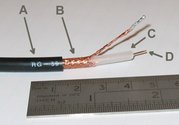Cable television or Community Antenna Television (CATV) (often shortened to cable) is a system of providing television, FM radio programming and other services to consumers via radio frequency signals transmitted directly to people’s televisions through fixed optical fibers or coaxial cables as opposed to the over-the-air method used in traditional television broadcasting (via radio waves) in which a television antenna is required.
It is most commonplace in Canada, the United States, Europe, and much of East Asia, though it is present in many other countries, mainly in Australasia, South America and the Middle East. In Africa, cable TV has had little success, as it is not cost-effective to lay cables in sparsely populated areas, and although so-called "wireless cable" or microwave-based systems are used, "direct-to-home" satellite television is far more popular, especially in South Africa.
Technically, both cable TV and CATV involve distributing a number of television channels collected at a central location (called a headend) to subscribers within a community by means of a network of optical fibers and/or coaxial cables and broadband amplifiers.
As in the case of radio broadcasting, the use of different frequencies allows many channels to be distributed through the same cable, without separate wires for each. The tuner of the TV, VCR or radio selects one channel from this mixed signal.
The same program is often simultaneously broadcast by radio and distributed by cable, usually at different frequencies. Other programs may be distributed by cable only; rules restricting content (e.g. regarding nudity and pornography) are often more relaxed for cable than for over-the-air TV.
Traditional cable TV systems worked strictly by way of analog signals (i.e. using standard radio waves) but many modern cable TV systems also employ the use of digital cable technology, which uses compressed digital signals, allowing them to provide many more channels than they could with analog alone.
Many cable television systems were formerly known as CATV (Community Antenna Television) systems as they were originally composed simply of a shared antenna located in a high location to which multiple households could have their TVs connected via coaxial cable. This was designed to provide access to television signals in areas where reception was traditionally poor. As cable-only networks began to appear on CATV systems, picked up via satellite rather than by antenna, the use of the term CATV has largely faded and the term cable television has taken its place.
History of U.S. cable television and its regulation
During the television licensing freeze of the late 1940s, the demand for television increased. Since new television licenses were not being issued, the only way the demand was met was by Community Antenna Television. The first commercial CATV System was developed in 1948 by John Walson. He had interest in an appliance store that began to carry televisions. A major problem in selling televisions in Mahanoy City, Pennsylvania was that the stations which were available were received very poorly. Walson built an antenna on the top of a nearby mountain and strung a wire from it to his shop. A neighbor asked for the wire to be connected to his house and Walson connected it to his own house. He said he would extend the wire to anyone who would buy one of his television receivers, and in 1949 he started charging for the service.
Read more at Wikipedia.org



